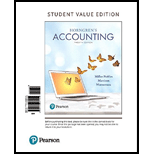
Payback Period: The Payback period is the time period in which the project recovers its initial cost.
ARR: Accounting
The formula to calculate ARR is as follows:
NPV:
Profitability Index: Profitability Index is similar to the NPV method to evaluate a project. It calculates the ratio between the present value
IRR:
1. Payback Period:
To determine: The payback period for both projects
2. Accounting Rate of Return (ARR):
To determine: The Accounting Rate of Return (ARR) for both projects
3. Net Present Value (NPV):
To determine: The Net Present Value (NPV) using excel PV function
4. Internal Rate of Return (IRR):
To determine: The Internal Rate of Return (IRR) using excel function
2. Investment decision:
To decide: In which server the investment should be made
Want to see the full answer?
Check out a sample textbook solution
Chapter 26 Solutions
Horngren's Accounting, Student Value Edition (12th Edition)
- Walsh plc sells wash machines and provides a one-year warranty against faults occurring after sale. Platt estimates that if all goods under warranty at its statement of financial position date of 31 December 2022 need minor repairs the total cost would be £ 6 million. If all the products under warranty needed minor repairs the total cost would be £ 24 million. At 31 December 2023 these amounts have risen to £ 7 million and £ 26 million respectively. Based on previous years` experience, Walsh estimates that the 80% of the products will require no repairs, 18% will require minor repairs and 2% will require major repairs. During the year ended 31 December 2023 actual costs of repair under the warranty amounted to £ 1,400,000. Required: a. b. What are the distinctions between liabilities, provisions and contingent liabilities under IAS 37 “Provisions”? Explain the accounting treatment of the warranty in Walsh plc`s financial statements for the year ended 31 December 2023, qualifying…arrow_forwardPlease provide answer this financial accounting questionarrow_forwardI need help finding the accurate solution to this financial accounting problem with valid methods.arrow_forward

 AccountingAccountingISBN:9781337272094Author:WARREN, Carl S., Reeve, James M., Duchac, Jonathan E.Publisher:Cengage Learning,
AccountingAccountingISBN:9781337272094Author:WARREN, Carl S., Reeve, James M., Duchac, Jonathan E.Publisher:Cengage Learning, Accounting Information SystemsAccountingISBN:9781337619202Author:Hall, James A.Publisher:Cengage Learning,
Accounting Information SystemsAccountingISBN:9781337619202Author:Hall, James A.Publisher:Cengage Learning, Horngren's Cost Accounting: A Managerial Emphasis...AccountingISBN:9780134475585Author:Srikant M. Datar, Madhav V. RajanPublisher:PEARSON
Horngren's Cost Accounting: A Managerial Emphasis...AccountingISBN:9780134475585Author:Srikant M. Datar, Madhav V. RajanPublisher:PEARSON Intermediate AccountingAccountingISBN:9781259722660Author:J. David Spiceland, Mark W. Nelson, Wayne M ThomasPublisher:McGraw-Hill Education
Intermediate AccountingAccountingISBN:9781259722660Author:J. David Spiceland, Mark W. Nelson, Wayne M ThomasPublisher:McGraw-Hill Education Financial and Managerial AccountingAccountingISBN:9781259726705Author:John J Wild, Ken W. Shaw, Barbara Chiappetta Fundamental Accounting PrinciplesPublisher:McGraw-Hill Education
Financial and Managerial AccountingAccountingISBN:9781259726705Author:John J Wild, Ken W. Shaw, Barbara Chiappetta Fundamental Accounting PrinciplesPublisher:McGraw-Hill Education





